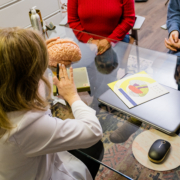Understanding Conditions of Aging, Frontotemporal Dementia
When actor Bruce Willis was diagnosed with Frontotemporal Dementia (FTD) earlier this year, it thrust the degenerative neurological condition into the national spotlight. Many people learned about FTD for the first time. The stories served as a sobering reminder of how our brains change as we age. Dr. Andrew Budson, chief of cognitive and behavioral neurology and director of the Center for Translational Cognitive Neuroscience at the Veterans Affairs Boston Healthcare System, is an expert on that subject. Dr. Budson has co-authored several books, including a new work titled, “Seven Steps to Managing Your Aging Memory: What’s Normal, What’s Not, and What to Do About It.” BrainWise managing editor Matt Villano recently sat down with Dr. Budson to discuss the conditions of aging and how we can better understand what happens to our brains as we mature. What follows is an edited transcript of their conversation.
BrainWise: What are the most common misconceptions about Frontotemporal Dementia (FTD) and what separates it from dementia more generally?
Dr. Budson: Dementia is a general term that we use when people’s thinking and memory have gone downhill and deteriorated to the point that it interferes with day-to-day function. Alzheimer’s disease is one type or one cause of dementia and frontotemporal dementia, abbreviated as FTD, is another type or cause of dementia. FTD basically comes in two types: language variants and behavior variants. The language variants are off in their own world; we now call them primary progressive aphasias. When Bruce Willis was initially diagnosed with aphasia, I would say what that means is he had primary progressive aphasia. The causes of aphasia could be a stroke, a brain tumor, a traumatic brain injury, or it could be a neurodegenerative disease like a frontotemporal dementia variant. FTD affects the temporal lobes. That’s why it tends to affect language, because our store of knowledge and our ability to speak are both close to the temporal lobes. The temporal lobe is our storehouse of words. Names of people, names of animals, names of tools—they’re all in there. People with disruptions to those parts of the temporal lobes may not recognize a word and forget what something is all together. I had one patient with FTD, and this person had lost the words for many body parts. I asked him, ‘What’s an elbow?’ And he was like, “Elbow. I know the word elbow, but I don’t know what it means.” This person also didn’t know what a knee was. Or a foot. It was very interesting.
BrainWise: So with primary progressive aphasia, the word itself doesn’t disappear, but rather the connection between the word and the definition?
Dr. Budson: That’s right. People can lose what a fork is for or something like that. They may be like Ariel in ‘The Little Mermaid,’ who comes across a fork and thinks it’s used to twirl her hair or something like that. It’s like if you grew up in a culture that just didn’t have forks, so you’d never seen one before. You had no idea what to do with it. Those sorts of things can happen. There are other types of language variants of frontotemporal dementia. People can have trouble getting the words out. They may know exactly what they want to say. They haven’t lost the words, but they have trouble getting the words out.
Behavioral variant frontotemporal dementia is when the frontal lobe is deteriorating, and patients began struggling with everyday life. In some cases, patients will have trouble completing complicate tasks or they’ll just become apathetic—they’ll just sit there like a bump on a log. In these cases, the deterioration is impacting the top and outer part of the frontal lobe, also known as the dorsolateral. In cases where the damage to the frontal lobe is on the bottom or the middle—the ventral medial—people become uninhibited, and they can’t control their urges. They may act or say or do whatever comes to mind without any filter. Of course, this can lead to aggression if the person’s asked to do something they don’t want to do. All these situations are difficult to endure as a patient and difficult to watch as a family member. They’re all variations of FTD.
BrainWise: So back to the Willis case for a moment. Is it safe to say that aphasia is a symptom of the language variant of FTD, or is aphasia its own genre of FTD?
Dr. Budson: It’s almost both, and the reason I say it like that is when people first present, when they first come to the doctor with problems speaking that have come on gradually and an evaluation is done, that would always include an MRI scan and some type of language cognitive testing. If they’re not having any behavior problems, we would assume it is primary progressive aphasia. Now, as the frontotemporal dementia progresses, so what happens is more and more of the brain becomes involved. Basically, what I’m saying is that people who start with primary progressive aphasia, especially if it’s due to frontotemporal dementia, will experience spread and will begin to have behavior problems too.
I have never met Bruce Willis. I have certainly never examined him, but I would speculate that because we are first told he had aphasia, which I thought from the start must be primary progressive aphasia. Then later we’re told he has FTD, he has frontotemporal dementia. My speculation is that it was always a form of frontotemporal dementia that began with the temporal lobes being involved, causing language problems. It then spread to the frontal lobes causing behavior problems as well, and that’s when we heard on the news it was FTD.
BrainWise: How common is FTD? How prevalent is this in a population of people over age 65?
Dr. Budson: In a population of 65-plus, I would estimate it’s probably somewhere around 50 times less common than Alzheimer’s.
BrainWise: And what is that number?
Dr. Budson: By the time people reach the age of 85, approximately 40% of those 85 and older have Alzheimer’s. The dementias do become more common as people get older. One of the interesting things about frontotemporal dementia is although approximately a quarter of patients do present above age 65, three-quarters of them present younger than age 65. It’s a more common cause of dementia in younger people. The ages of patients there usually fall into the 45 to 65 range.
BrainWise: Why is there a link between age and brain development over time and memory loss?
Dr. Budson: We don’t fully know the answer as to why these different disorders of thinking and memory develop. With Alzheimer’s, there are two collections of proteins. One of them is outside the cell and it’s called amyloid or sometimes beta-amyloid. Then there’s another collection of proteins inside the cell, and that is known as tau. Together, especially things go wrong, they can be very problematic. Again, with Alzehimer’s, problems start with the deposition of these amyloid proteins where the amyloid clusters and clumps together to form plaques. The plaques get bigger and bigger. They start to interfere with neighboring brain cells. There’s an inflammatory reaction, that causes the tau to be released inside the cells which forms long chains. The chains get tangled up. Eventually, these tangles kill the cells.
Why does this happen when people get older? There is a school of thought that I’m a believer in, that the normal function of amyloid in the brain is to help fight off brain infections. Bacteria, virus, fungi, things like that. We all make a little bit of amyloid every day, and we normally clear it away while we’re sleeping, which is one of many reasons why it’s important to get a good night’s rest. Well with Alzheimer’s patients, there either be too much amyloid being made, or not enough of it being cleared away. Tau tangles also can self-propagate. They can essentially move from one brain cell to another through the connections that brain cells have, and it can cause the tau to get tangled up in another brain region. Once this process starts, it can spread.
In terms of frontotemporal dementia, some of the proteins are the same. Unlike Alzheimer’s Disease which we think is a single pathology, in frontotemporal dementia, there’s like a family of maybe up to a dozen different pathologies, and roughly a dozen different abnormal proteins. The two that are most common are the tau and another protein that is called TDP-43. The 43 is how much it weighs in molecular weight, and the TDP stands for transactive DNA-binding protein. TDP-43 can affect people when they’re young and cause frontotemporal dementia for them in their 40s, 50s and 60s.
BrainWise: To what extent can these tau proteins help or contribute to the growth of someone’s brain?
Dr. Budson: The normal function of the tau is to help stabilize these very small tubes called microtubules inside neurons. Neurons have these long processes like long arms that reach out to touch other neurons, and that’s how the brain cells communicate with one another. In order to pass information and substances like proteins from one part of the neuron to another, neurons send them through these tiny microtubules.
BrainWise: Right now, how can people put themselves in a position to live longer and maybe stave off catastrophic memory loss?
Dr. Budson: We’ve really made tremendous strides over the last hundred years in understanding what causes memory loss, what causes dementia. We now understand the brain structures that are involved. We understand many of the abnormal proteins that are doing the damage. We are the furthest along on Alzheimer’s. There’s FDA-approved medications that can help to improve memory function among Alzheimer’s patients equivalent to turning the clock back on the memory loss. For people with FTDs, the main class of medications that can help these individuals if they have behavior problems are the Prozac family of medications, or selective serotonin re-uptake inhibitors. My personal two favorites in this class are Sertraline (Zoloft) and Escitalopram (Lexapro). Those I think work quite well in patients that are having behavioral problems, and there’s good evidence to show that these types of medications are helpful for them.
That’s just medicine. It’s important to engage in aerobic exercise, which releases growth factors from the brain that help us to grow new brain cells—no matter how old we are. Eating right is also important, and people should do their best to stay away from highly processed foods. Sleep is critical, and you want to try to get the right amount of sleep for you. That could be seven hours or nine hours, but I know it’s not five hours. Nobody’s right amount of sleep is five hours. People that try and sleep five hours or less not only have an increased risk of Alzheimer’s or other types of dementia, but they also have an increased risk of death. Other things that have been shown to be beneficial are staying socially active and engaging in novel, cognitively stimulating activities. There’s even a benefit from music.
BrainWise: What questions will you ask in your research next?
Dr. Budson: I am working on developing new strategies and memory aids that can help people to remember things better in day-to-day life without medications (or in addition to medications). Basically, I’m looking to extend the mild-memory phase of Alzheimer’s Disease. I’m also trying to understand the biological basis of thinking and memory and consciousness. I wrote a 30,000-word scientific article that was published in the December 2022 issue of Cognitive Behavioral Neurology. The article explains what I think is the relationship between memory and consciousness and about how if we understand this relationship, not only can we understand memory better, but we can also understand consciousness better. I’m excited about where it will lead.
BrainWise: Why did you choose to study this area of brain science in particular?
Dr. Budson: I’m particularly interested in memory and thinking. As early as high school, I really wanted to understand what are the biological bases of thinking, memory, and consciousness? I’ve maintained that interest throughout my career. Along the way a fascinating thing has happened. As soon as I started to care for patients, I found tremendous satisfaction at being able to help them with memory problems. I have been able to do that a little bit through medications, a little bit through strategies. The other thing that I found is that there’s a lot of neurodegenerative diseases, a lot of different types of dementias that we don’t have effective treatments for. With Alzheimer’s, we can do something, we can’t do everything. Frontotemporal dementia, we can do even less. I realized there’s a lot of good that can be done by just helping families understand what’s going on, helping individuals understand what’s going on with their thinking and memory or language or other types of things. I’ve always wanted to really understand what’s going on at a very deep level so that I can help individuals and their loved ones understand these things too.
If you’ve been diagnosed with FTD or you have a loved one who has been diagnosed, and want to understand more, please reach out to a NAN neuropsychologist or a neurologist for more information.

This website may contain third party advertisements and links to third party sites. NAN does not endorse or make any representation as to the accuracy of the information contained in such advertisements. Third party advertisements and links to other sites are not intended to be endorsements or recommendations by NAN of the third party sites, goods or services.










